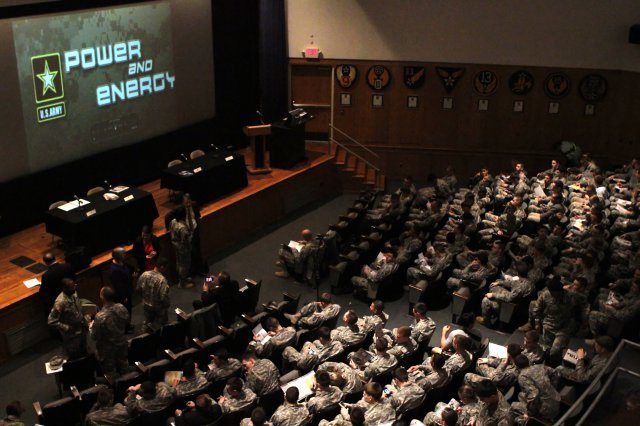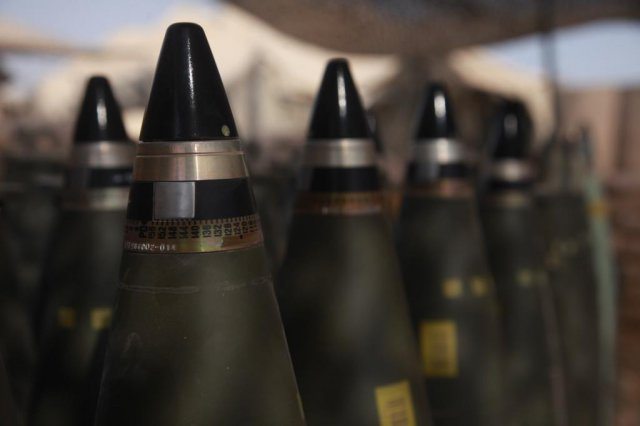More than 580 cadets squeezed into Arnold Auditorium March 27, to hear from four senior Army leaders on the subject of developing a more energy-informed culture.
Lt. Gen. Raymond V. Mason, the Department of the Army deputy chief of staff for logistics, told cadets the Army’s push to develop energy-efficient technologies and train its Soldiers to be energy-conscious is all about the warfighters.
“This focus on operational energy is not about, necessarily, trying to save fuel,” Mason said. “It’s about making you more combat-effective and reducing your risk.”
For one gallon of generator fuel and water used, it requires seven gallons to transport. In combat, it takes more than 20 gallons of fuel per day to sustain each Soldier, according to the U.S. Army Operational Energy Office. Mason said an Army that can make energy-informed decisions will save Soldiers lives just by reducing the number of fuel and water convoys traveling to outposts and forward operating bases, known as FOBs.
“There’s a risk to your Soldiers getting there and then with 20 vehicles at the gate. That’s 20 opportunities for the bad guys to get inside the FOB,” Mason said. “If we can help reduce it down by five trucks through operational energy programs, I’ve reduced your risk by 20 percent.”
Still, developing energy independence is a strategy needed to further eliminate risk. Easy access to fuel and energy has been an advantage the Army has based its combat operations around for the past two decades, Mason said.
“The enemies we are going to fight in the future will try to deny us that access,” he said.
Every Soldier in an infantry squad carries 23 batteries just to power equipment on a 72-hour mission. New technology, like the Soldier Worn Integrated Power Equipment System, or SWIPES, is being produced to both lighten the load and increase performance in the field.
“We’re trying to give them a lot of capabilities so that a squad can be as autonomous and last as long as they can,” Mason said.
The panel discussion was the culminating event in the daylong Army Energy-Informed Culture Summit. Joining Mason on the panel were Tad Davis, the U.S. Army Reserve Command’s director of Services and Infrastructure Core Enterprise; Brig. Gen. Michael Stone, the Michigan National Guard assistant adjutant general; and the Honorable Katherine Hammack, the assistant secretary of the Army for Installations, Energy and Environment.
Hammack, who chose West Point in 2011 as one of the pilot installations for the Army’s Net Zero Energy program, spoke on the theme of enhancing mission effectiveness through an energy-informed culture.
“That’s really what it’s about — ensuring all of our Soldiers have energy at the right place and the right time to do their mission while at the same time we reduce risk and vulnerability,” Hammack said. “Because, really, the Army’s ability to accomplish our mission on a global scale depends upon secure, uninterrupted access to power and energy.”
The Net Zero Energy initiative is an integrated approach to reaching the Army’s goal of producing as much energy as consumed on an installation over a period of one year. The other two components of Net Zero relates to water and waste. Hammack is not a fan of plastic water bottles and said anyone who attends a meeting with one tends to get a lecture from her on the subject.
“Every plastic water bottle takes four ounces of petroleum to make the water bottle, to process the water, to fill the bottle, to distribute the water bottles and then to process them at its end of life,” Hammack said. “When you go over into theater, you see plastic water bottles everywhere you go. Somehow, we as an Army thought that we can’t fight without using plastic water bottles.”
Net Zero extends to the battlefield too, Hammack said. One forward operating base in Afghanistan had received an aerial resupply every three days, with 70-80 percent of the cargo being fuel and water.
“In one month, our Net Zero to the Edge team was able to reduce it to one aerial resupply every 10 days and what that meant was Soldiers were able to be more mission-effective,” Hammack said. “They could focus on the mission and not the resupply, and we could also return a lot of our aerial assets to other duties.”
The challenge is developing technologies and a culture which will make energy opportunities and not vulnerabilities. Nearly a year ago, Hammack visited the academy on Projects Day to see how cadets were approaching this challenge with their research-based exploration. During the summit, Hammack again met with cadets who briefed her on projects related to energy security and pricing strategies.
“You are the future Army leaders. This is going to be your job to figure out how we’re going to be operating in the future,” Hammack said. “You have an opportunity to improve operations with an energy-informed culture. And to get there you have to understand the mission benefits.”
Key leaders from DA G-4, U.S. Training and Doctrine Command, or TRADOC, Combined Arms Support Command, known as CASCOM, and the U.S. Military Academy met with the Core Interdisciplinary Team faculty who’ve developed an integrated approach to energy education within the core curriculum. The Class of 2016 is the first to receive energy-related topics into their chemistry, math, information technology, psychology and English courses. Furthermore, the chemistry capstone involves a two-day interdisciplinary problem-solving exercise using the SWIPES gear.
It doesn’t end after the plebe year, one course director said. It continues throughout the cadets’ 47 months at West Point through projects, independent studies and training exercises.
“By the time they leave here, you’re going to have a class of cadets who are going to be much more aware of their environment and how operational energy impacts that environment than probably any class before them,” Col. Joseph Shannon, General Chemistry program director, said.
The “integrated, not additive concept” allows departments to enhance curriculum without added courses, or costs.
“For instance, in chemistry, we added virtually nothing into our curriculum, but what we did was take the existing curriculum and found opportunities to weave operational energy in,” Shannon said. “There was no additional cost factor in terms of new lessons or new materials.”
The goal, he said, which came from discussions with CASCOM and TRADOC leaders is to create synergy between the organizations as cadets transition into officers and receive advanced training under those commands.
“We want to ensure that what we are doing here is going to feed seamlessly into what they will do as lieutenants in the Army,” Shannon said. “We don’t want this to be a different kind of experience and out of synch once they leave.”
Lt. Col. Mark Smith, Department from the Department of Geography and Environmental Engineering, led small group back briefs to the key leaders. Five cadet-driven dialogues debated topics ranging from how to develop an energy-informed culture and avoiding cynicism, to ways of better leveraging the academy’s intellectual capital and incorporating operational energy into cadet summer training.
Smith said the sessions revealed that organizations often fail to have an energy-informed culture because of a lack of education and awareness, and sometimes there’s a lack of leadership emphasis. Cynicism derived from energy initiatives is produced by a lack of communication, distrust of the motives or when organization members don’t fully understand the problem.
Additional briefings were held with members of the West Point Energy Council, provided by Col. Russ Lachance from the Department of Chemistry and Life Sciences; Lt. Col. Darcy Schnack moderated a session to include faculty from the Department of Behavioral Sciences and Leadership, where Mason turned to cadets for their opinions on affecting cultural change.
Class of 2013 Cadet Justin Gleeson, a future infantry officer, said it may have to start with the Noncommissioned Officer, or NCO, Corps.
“The backbone of the Army, from what we’re taught, is the NCO Corps and your Soldiers,” Gleeson said. “If you can inspire them you’ll get the change you want.”
Gleeson said it’s the officers’ responsibility to be transparent enough to explain the life-saving rationale behind operational energy programs and make their NCOs and Soldiers understand this is the right decision.
“They’ll respond to that,” Gleeson said. “But if you just put it in a memo, they might think otherwise like my priority is to keep my Soldiers’ safe so I’m going to keep to the status quo because that is what’s working right now.”
Gleeson also offered suggestions that have worked within the Corps of Cadets’ recycling program — ease of use and incentives.
“I think your grassroots approach is exactly right,” Mason said. “I think your observation of not over thinking it and keeping it at a low-level of execution is very intuitive.”
Another cadet suggested the time is right for executing operational energy programs as the Army draws down its forces and battles with budget cuts.
“This issue of culture change and getting down to a grassroots level of change, I think, is value-based. You will take care of what you value,” Mason said.











